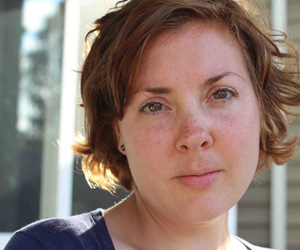A Deserted Landscape: Karen Bannister in Conversation with Simone Littledale

Malahat volunteer Karen Bannister talks with Simone Littledale on symbolism and place in her poem, "Huracan," which appears in Issue #185, Winter 2013.
When I read your poem, “Huracan,” I was immediately struck by the menagerie of animals throughout. Animals can be so symbolic. What roles do you feel these animals play in your poem? What do they mean to you? Are you able to reflect on their place in the narrative?
Aside from poetry, my greatest obsession is animals, so naturally my work is full of creatures great and small. In this poem in particular, I tried to express the way in which the desert sort of consumes everything by showing the domestic animals like cows and goats just wandering around half-feral. I also wanted to show the richness of a landscape that, at a glance, might seem desolate and inhabitable though the wide variety of local fauna. In fact, next to the Amazon, the desert is one of the liveliest places I've ever been. In terms of straight symbolism, I invite the reader to glean whatever they like from each animal because it's very subjective. For example, to me, a vulture is a good thing; a sign of a healthy ecosystem. To others it might mean death or corruption.
I was also struck by the feelings evoked in me as I read, such as the dry, hot, dusty presence of the landscape you constructed. What prepares you to evoke this sense of "desert" in your reader? Where does this inspiration come from?
The inspiration for the setting came from a trip I took two years ago to a rural part of the Baja Peninsula in Mexico. It is one of the most dramatic places I have ever been―classic desert with roadrunners and dusty cow skulls, right next to the Sea of Cortez, which is one of the most bio-diverse seas on the planet. The best way to really get a handle on the setting was frankly to walk out into the desert, sit down on a rock, and just watch what the heat was doing.
Talk me through the process of writing this poem.
The inspirational foundation of the poem is pretty pedestrian; my brother and I wanted Cokes, so we biked into town, but the light at that hour was incredible, the time when all the cows and goats start moving back to their corrals for the evening. I also drew from other moments in the trip, like watching a woman burn palm leaves in an oil drum, and from things I saw every day; dead puffer fish, and the wind-wasted highway.
Being mentored by John Barton, the editor of the Malahat, was fantastic―I was actually pretty stuck with this poem and he was a huge help. He would gently suggest something and then let me work things out for myself, which was great. It helps that he is a poet himself and really understands the guts of poetry. I'm very happy with the poem's current state―I won't call it an end product because I have only "finished" maybe two poems in my whole life. And even now as I think about them I'm starting to doubt myself, damn.
How does this publication impact the curve of your career?
This is my first publication in a "professional" setting, so to speak. When I got the news, I did not conduct myself in a composed and ladylike manner. That email was the first sort of real, tangible indication that I actually might have a shot at this writing thing―I’m definitely less nervous about submitting now.
You did an amazing job of juxtaposing the characters against a vivid landscape. What do you think of this relationship, of humans with their world?
I think there are certain wild and ancient places on this planet that remind you that, even at 22, with a piece of university stationery that says "I did it," you'll always be a dumb kid, drinking Coke with your brother in the shadow of a cactus that's older than the constitution.

Karen Bannister
* * * * * * * *









